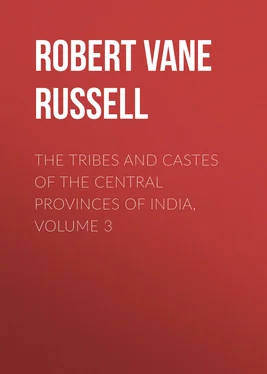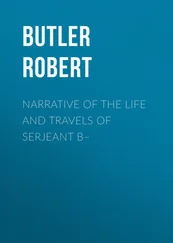Robert Vane Russell - The Tribes and Castes of the Central Provinces of India, Volume 3
Здесь есть возможность читать онлайн «Robert Vane Russell - The Tribes and Castes of the Central Provinces of India, Volume 3» — ознакомительный отрывок электронной книги совершенно бесплатно, а после прочтения отрывка купить полную версию. В некоторых случаях можно слушать аудио, скачать через торрент в формате fb2 и присутствует краткое содержание. Жанр: foreign_prose, История, foreign_edu, foreign_antique, на английском языке. Описание произведения, (предисловие) а так же отзывы посетителей доступны на портале библиотеки ЛибКат.
- Название:The Tribes and Castes of the Central Provinces of India, Volume 3
- Автор:
- Жанр:
- Год:неизвестен
- ISBN:нет данных
- Рейтинг книги:5 / 5. Голосов: 1
-
Избранное:Добавить в избранное
- Отзывы:
-
Ваша оценка:
- 100
- 1
- 2
- 3
- 4
- 5
The Tribes and Castes of the Central Provinces of India, Volume 3: краткое содержание, описание и аннотация
Предлагаем к чтению аннотацию, описание, краткое содержание или предисловие (зависит от того, что написал сам автор книги «The Tribes and Castes of the Central Provinces of India, Volume 3»). Если вы не нашли необходимую информацию о книге — напишите в комментариях, мы постараемся отыскать её.
The Tribes and Castes of the Central Provinces of India, Volume 3 — читать онлайн ознакомительный отрывок
Ниже представлен текст книги, разбитый по страницам. Система сохранения места последней прочитанной страницы, позволяет с удобством читать онлайн бесплатно книгу «The Tribes and Castes of the Central Provinces of India, Volume 3», без необходимости каждый раз заново искать на чём Вы остановились. Поставьте закладку, и сможете в любой момент перейти на страницу, на которой закончили чтение.
Интервал:
Закладка:
Gandhmāli
Gandhmāli, 15 15 This article is compiled from papers by Mr. Jhanjhan Rai, Tahsīldār, Sārangarh, and Satyabādi Misra of the Sambalpur Census office.
Thānāpati.—The caste of village priests of the temples of Siva or Mahādeo in Sambalpur and the Uriya States. They numbered about 700 persons in the Central Provinces in 1911. The caste appears to be an offshoot of the Mālis or gardeners, differentiated from them by their special occupation of temple attendants. In Hindustān the priests of Siva’s temples in villages are often Mālis, and in the Marātha country they are Guraos, another special caste, or Phulmālis. Some members of the caste in Sambalpur, however, aspire to Rājpūt origin and wear the sacred thread. These prefer the designation of Thānāpati or ‘Master of the sacred place,’ and call the others who do not wear the thread Gandhmālis. Gandh means incense. The Thānāpatis say that on one occasion a Rājpūt prince from Jaipur made a pilgrimage to the temple of Jagannāth at Puri, and on his return stopped at the celebrated temple of Mahādeo at Huma near Sambalpur. Mahādeo appeared before the prince and asked him to become his priest; the Rājpūt asked to be excused as he was old, but Mahādeo promised him three sons, which he duly obtained and in gratitude dedicated them to the service of the god. From these sons the Thānāpatis say that they are descended, but the claim is no doubt quite illusory. The truth is, probably, that the Thānāpatis are priests of the temples situated in towns and large villages, and owing to their calling have obtained considerable social estimation, which they desire to justify and place on an enduring basis by their claim to Rājpūt ancestry; while the Gandhmālis are village priests, more or less in the position of village menials and below the cultivating castes, and any such pretensions would therefore in their case be quite untenable. There are signs of the cessation of intermarriage between the two groups, but this has not been brought about as yet, probably owing to the paucity of members in the caste and the difficulty of arranging matches. Three functional subdivisions also appear to be in process of formation, the Pujāris or priests of Mahādeo’s temples, the Bandhādias or those who worship him on the banks of tanks, and the Mundjhulas 16 16 Mund-jhulānā , to swing the head.
or devotees of the goddess Somlai in Sambalpur, on whom the inspiration of the goddess descends, making them shake and roll their heads. When in this state they are believed to drink the blood flowing from goats sacrificed in the temple. For the purposes of marriage the caste is divided into exogamous groups or bargas , the names of which are usually titles or designations of offices. Marriage within the barga is prohibited. When the bride is brought to the altar in the marriage ceremony, she throws a garland of jasmine flowers on the neck of the bridegroom. This custom resembles the old Swayamwāra form of marriage, in which a girl chose her own husband by throwing a garland of flowers round his neck. But it probably has no connection with this and merely denotes the fact that the caste are gardeners by profession, similar ceremonies typifying the caste calling being commonly performed at marriages, especially among the Telugu castes. Girls should be married before adolescence and, as is usual among the Uriya castes, if no suitable husband is forthcoming a symbolic marriage is celebrated; the Thānāpatis make her go through the form with her maternal grandfather or sister’s husband, and in default of them with a tree. She is then immediately divorced and disposed of as a widow. Divorce and the remarriage of widows are permitted. A bachelor marrying a widow must first go through the ceremony with a flower. The Gandhmālis, as the priests of Mahādeo, are generally Saivas and wear red clothes covered with ochre. They consider that their ultimate ancestor is the Nāg or cobra and especially observe the festival of Nāg-Panchmi, abstaining from any cooked food on that day. They both burn and bury the dead and perform the shrāddh ceremony or the offering of sacrificial cakes. They eat flesh but do not drink liquor. Their social position is fairly good and Brāhmans will take water from their hands. Many of them hold free grants of land in return for their services at the temples. A few are ordinary cultivators.
Gārpagāri
1. Origin of the caste
Gārpagāri. 17 17 Based on notes taken by Mr. Hīrā Lāl at Chānda and the notices of the Gārpagāri in the District Gazetteers.
—A caste of village menials whose function it is to avert hailstorms from the crops. They are found principally in the Marātha Districts of the Nāgpur country and Berār, and numbered 9000 persons in 1911. The name is derived from the Marāthi gār , hail. The Gārpagāris are really Nāths or Jogis who have taken to this calling and become a separate caste. They wear clothes coloured with red ochre, and a garland of rudrāksha beads, and bury their dead in a sitting posture. According to their tradition the first Gārpagāri was one Rāut, a Jogi, who accompanied a Kunbi mālguzār on a visit to Benāres, and while there he prophesied that on a certain day all the crops of their village would be destroyed by a hailstorm. The Kunbi then besought him to save the crops if he could, and he answered that by his magic he could draw off the hail from the rest of the village and concentrate it in his own field, and he agreed to do this if the cultivators would recompense him for his loss. When the two came home to their village they found that there had been a severe hailstorm, but it had all fallen in the Jogi’s field. His loss was made good to him and he adopted this calling as a profession, becoming the first Gārpagāri, and being paid by contributions from the proprietor and tenants. There are no subcastes except that the Kharchi Gārpagāri are a bastard group, with whom the others refuse to intermarry.
2. Marriage
Marriage is regulated by exogamous groups, two of which, Watāri from the Otāri or brass-worker, and Dhankar from the Dhangar or shepherds, are named after other castes. Some are derived from the names of animals, as Harnya from the black-buck, and Wāgh from the tiger. The Diunde group take their name from diundi , the kotwar’s 18 18 Village watchman.
drum. They say that their ancestor was so named because he killed his brother, and was proclaimed as an outlaw by beat of drum. The marriage of members of the same group is forbidden and also that of the children of two sisters, so long as the relationship between them is remembered. The caste usually celebrate their weddings after those of the Kunbis, on whom they depend for contributions to their expenses. Widow-marriage is permitted, but the widow sometimes refuses to marry again, and, becoming a Bhagat or devotee, performs long pilgrimages in male attire. Divorce is permitted, but as women are scarce, is rarely resorted to. The Gārpagāris say, “If one would not throw away a vegetable worth a damri (one-eighth of a pice or farthing), how shall one throw away a wife who is 3½ cubits long.” A divorced wife is allowed to marry again.
3. Religion
The caste worship Mahādeo or Siva and Mahābīr or Hanumān, and do not usually distinguish them. Their principal festival is called Māhi and takes place on the first day of Poush (December), this being the day from which hailstorms may be expected to occur; and next to this Māndo Amāwas, or the first day of Chait (March), after which hailstorms need not be feared. They offer goats to Mahādeo in his terrible form of Kāl Bhairava, and during the ceremony the Kunbis beat the dāheka , a small drum with bells, to enhance the effect of the sacrifice, so that their crops may be saved. When a man is at the point of death he is placed in the sitting posture in which he is to be buried, for fear that after death his limbs may become so stiff that they cannot be made to assume it. The corpse is carried to the grave in a cloth coloured with red ochre. A gourd containing pulse and rice, a pice coin, and a small quantity of any drug to which the deceased may have been addicted in life are placed in the hands, and the grave is filled in with earth and salt. A lamp is lighted on the place where the death occurred, for one night, and on the third day a cocoanut is broken there, after which mourning ends and the house is cleaned. A stone brought from the bed of a river is plastered down on to the grave with clay, and this may perhaps represent the dead man’s spirit.
Читать дальшеИнтервал:
Закладка:
Похожие книги на «The Tribes and Castes of the Central Provinces of India, Volume 3»
Представляем Вашему вниманию похожие книги на «The Tribes and Castes of the Central Provinces of India, Volume 3» списком для выбора. Мы отобрали схожую по названию и смыслу литературу в надежде предоставить читателям больше вариантов отыскать новые, интересные, ещё непрочитанные произведения.
Обсуждение, отзывы о книге «The Tribes and Castes of the Central Provinces of India, Volume 3» и просто собственные мнения читателей. Оставьте ваши комментарии, напишите, что Вы думаете о произведении, его смысле или главных героях. Укажите что конкретно понравилось, а что нет, и почему Вы так считаете.












